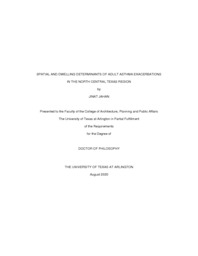
ATTENTION: The works hosted here are being migrated to a new repository that will consolidate resources, improve discoverability, and better show UTA's research impact on the global community. We will update authors as the migration progresses. Please see MavMatrix for more information.
Show simple item record
| dc.contributor.advisor | Li, Jianling | |
| dc.creator | Jahan, Jinat | |
| dc.date.accessioned | 2022-08-24T15:16:02Z | |
| dc.date.available | 2022-08-24T15:16:02Z | |
| dc.date.created | 2020-08 | |
| dc.date.issued | 2020-08-24 | |
| dc.date.submitted | August 2020 | |
| dc.identifier.uri | http://hdl.handle.net/10106/30883 | |
| dc.description.abstract | Asthma is an important public health concern as it is one of the major chronic diseases and is influenced by both environmental and genetic factors. The asthma situation is deteriorating in the North Central Texas. In such degrading condition of asthma, this research is one of the first attempts to investigate both indoor and outdoor environment quality and their relationships with adult asthma exacerbation i.e. adult asthma hospital admission rate in this region. To investigate this, I analyzed the geographical variation of about 12,000 adult patients hospitalized for asthma in the North Central Texas (NCT) Region and their association with the built environmental features such as land use types, dwelling characteristics, exposure to traffic at Census Block Group (CBG) level along with the concentration of pollutants at pertaining counties for the year 2014. Compared to previous studies, consideration of these factors can provide more location specific information. This is a key contribution of this research.
I have also investigated the social determinants of asthma at individual patient level as well as at CBG level. The results of my study indicate health discrepancy exists in this region since asthma hospitalization rate is significantly high (sig. <.10) in low income, low education attained and black population prominent neighborhoods. In addition, females of black race are more vulnerable compared to male as well as than females of other races.
In case of outdoor built environmental variables, several land uses such as timberland, cemeteries and group quarters (nursing homes, college dormitories, etc.) have statistically significant and inverse relationship with adult asthma hospitalization. In case of transportation variables, the weighted averaged road density, weighted traffic speed, total travel time to work were considered as proxy to traffic exposure for the residents of each census block groups. Only “total travel time to work” was statistically significant and have negative relationship with adult asthma hospitalization indicating people who have severe asthma tried to avoid long commuting time. In case of indoor environmental quality, I considered different types of fuel used for house heating, absence of complete plumbing and kitchen facilities and dwelling structures older than 40 years were also considered to observe how these parameters of dwellings were influencing adult asthma condition.
I have also considered air pollutants (ozone, particulate matter 2.5 and pollen) at macro scale (i.e. at county level) due to availability of data at county level. To observe the combined relationship of significant indoor and outdoor variables at census block group level as well as pollutants at county level on the asthma exacerbation, I applied multilevel/ hierarchical linear modeling. This is another unique aspect of this research. Finally, I tried to provide some policy recommendations based on the major findings from my analysis. | |
| dc.format.mimetype | application/pdf | |
| dc.language.iso | en_US | |
| dc.subject | Public health, built environmental variables, land use, transportation, dwelling condition, air pollutants | |
| dc.title | SPATIAL AND DWELLING DETERMINANTS OF ADULT ASTHMA EXACERBATIONS IN THE NORTH CENTRAL TEXAS REGION | |
| dc.type | Thesis | |
| dc.degree.department | Urban and Public Affairs | |
| dc.degree.name | Doctor of Philosophy in Urban Planning and Public Policy | |
| dc.date.updated | 2022-08-24T15:16:02Z | |
| thesis.degree.department | Urban and Public Affairs | |
| thesis.degree.grantor | The University of Texas at Arlington | |
| thesis.degree.level | Doctoral | |
| thesis.degree.name | Doctor of Philosophy in Urban Planning and Public Policy | |
| dc.type.material | text | |
Files in this item
- Name:
- JAHAN-DISSERTATION-2020.pdf
- Size:
- 5.478Mb
- Format:
- PDF
This item appears in the following Collection(s)
Show simple item record


